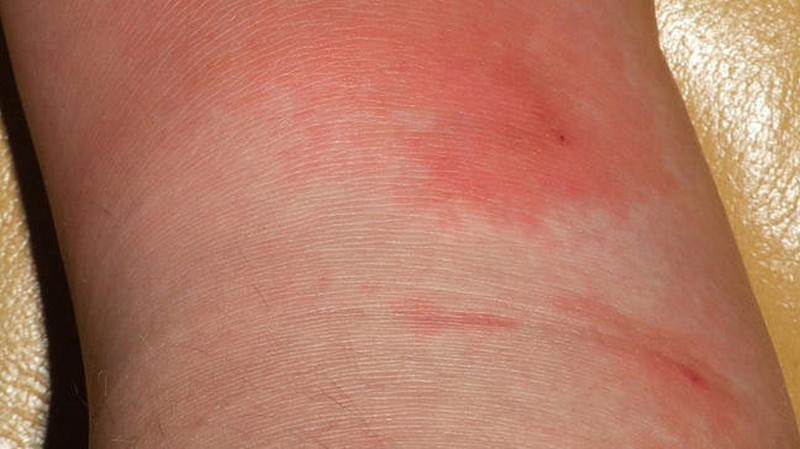Do you have a small area of redness and pain on your skin which rapidly spread into the surrounding tissues? Do you feel the typical signs of inflammation – swelling, redness, pain and warmth? You might be having cellulitis, a kind of bacterial infection which affects the skin and tissues beneath it. Read on to know more about this common bacterial skin infection.

What Is Cellulitis?
Cellulitis is a bacterial infection which is fairly common and involves the deeper layers of the skin: subcutaneous tissue and dermis. Initially, the infected area appears as swollen and red and when you touch it, it feels tender and hot. The swelling and redness will rapidly spread to other areas.
What are responsible for cellulitis?
The main culprit of cellulitis is the two bacteria: staphylococcus and streptococcus. These are the same bacteria that are responsible for impetigo and other diseases. Other bacteria such as MRSA (methicillin-resistant Staph aereus), Pneumococcus, Hemophilus influenzae and Clostridium may also cause cellulitis.
This bacterial infection is common and affects people of all ages and races. The common affected are elderly and middle-aged people, although it may occur in people of any age. On a positive note, this infection is not contagious.
What Are the Symptoms of Cellulitis?
Now that we have answered "what is cellulitis", you would like to know the answer of this question to know this infection better.
Common symptoms of cellulitis are:
Inflammation or redness of the skin
Tenderness and pain in the affected area
A rash or skin sore that appears and spreads rapidly
Feeling warm in the area that is infected
A glossy, tight, swollen appearance on the skin
Fever
Abscess with formation of pus in the central area
Skin dimpling
Blisters
Indications of more serious cellulitis will show the following symptoms:
Chills
Shaking
Feeling unwell
Dizziness and lightheadedness
Fatigue
Muscle pains
Sweating
Cellulitis is vastly spreading if you notice these symptoms: blistering, drowsiness, lethargy and red streaks. If any of these symptoms occur, seek for medical help immediately.
Where Does Cellulitis Occur Usually?
Though cellulitis can occur anywhere on your body, the most common affected area is the legs – particularly the lower leg (in the area of the shinbone or tibia and in the foot). Other areas that are commonly affected are the arm, neck and head area.
It can also develop in the chest areas or abdomen for people that have trauma wounds or have just undergone a surgery. Cellulitis in the abdominal area may also develop for morbidly obese people.
In most cases, the infection appears on the surface of your skin, but the underlying tissues of your skin may also be affected. It can also spread to your bloodstream and lymph nodes.
It’s something that we should not shrug or dismiss off. Though noncontagious, it needs medical attention as soon as possible.
How to Treat Cellulitis
Medication
Patients are often prescribed with antibiotics by their doctors. There are different types of antibiotics that can be used in the treatment of cellulitis. The type of antibiotic that will be prescribed to you will depend on the type of bacteria suspected as the cause of infection.
The entire duration of the antibiotic treatment is usually 5-10 days; however, there are some cases where treatment may last 2 weeks or more. It is crucial that you follow the medication as directed and finish the duration of medication even if you are already feeling better.
Some patients complained of experiencing the reddening of their skin gets worse when they start the treatment of antibiotic, however, don’t stop taking the antibiotic because this will just subside in a couple of days.
You should contact your doctor immediately though if after starting taking the antibiotics, you are experiencing vomiting, fever or any worsening of the symptoms.
Home Remedies
There is no recommended home remedy treatment for cellulitis as it is needed a medical professional assistance. If you think that you have this infection, call your doctor immediately and:
Reduce pain and swelling by elevating the area that is affected
Keep hydrated
Take painkillers with the prescription of your doctor
Treatment Provided in Hospitals
A hospital treatment may be required for patients with severe cellulitis especially if they are vomiting, have a high fever, recurring cellulitis, are not responding to any treatments or the condition is deteriorating. Antibiotic is often given through a vein in their arm (using a drip or IV)
Now that we have an idea of "what is cellulitis" and its treatment, we can stop the infection from spreading to other area and provide fast recovery.
Could Cellulitis Be Prevented?
Prevention is better than cure. To prevent any infections, including cellulitis, take these precautionary measures when you have wound in your skin:
Clean your wound every day by washing it with a gentle soap and water.
Apply a protective ointment or cream. Over the counter antibiotic ointment provides protection for most of the surface wounds.
Use a bandage to cover your wounds. Make it a habit to change the bandage every day.
Take note of any possible sign of infection, such as pain, redness and drainage, and seek medical attention immediately.
Practice proper hygiene.
View All Comments /Add Comment